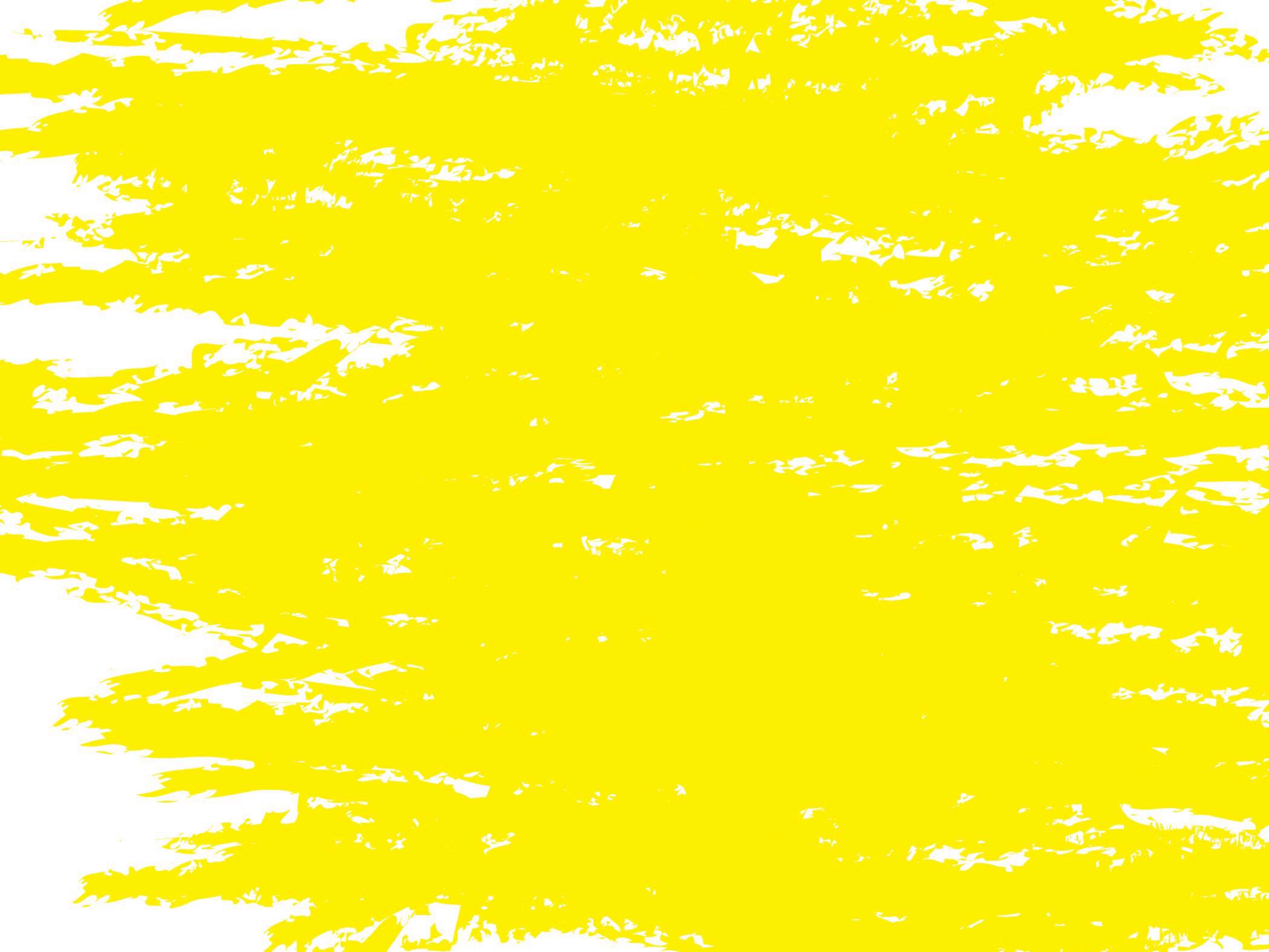STAR POST (ART)
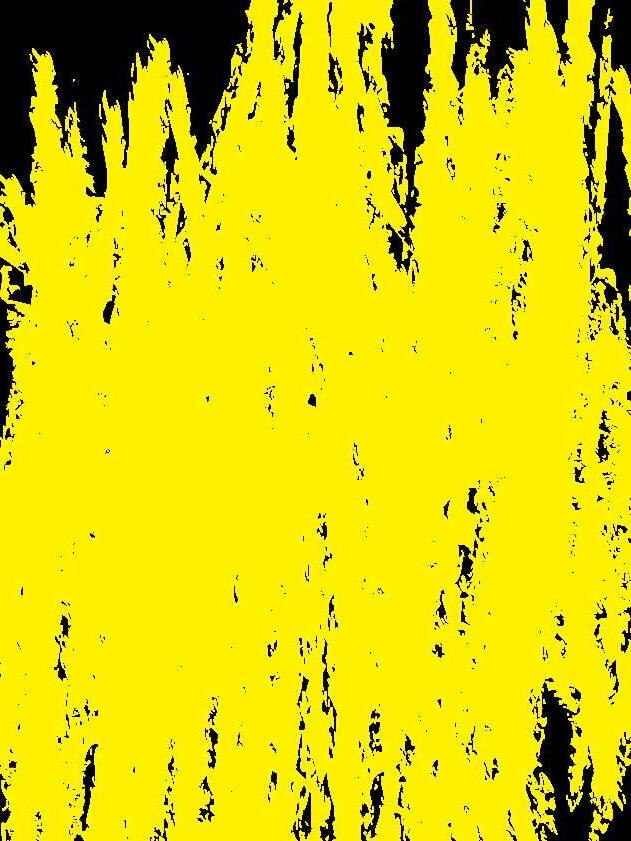
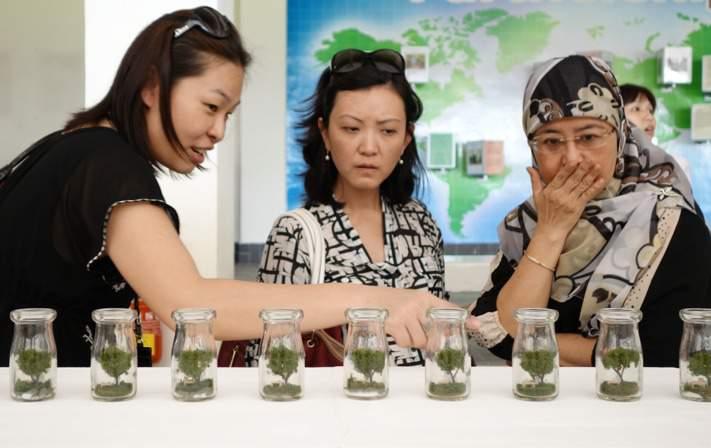



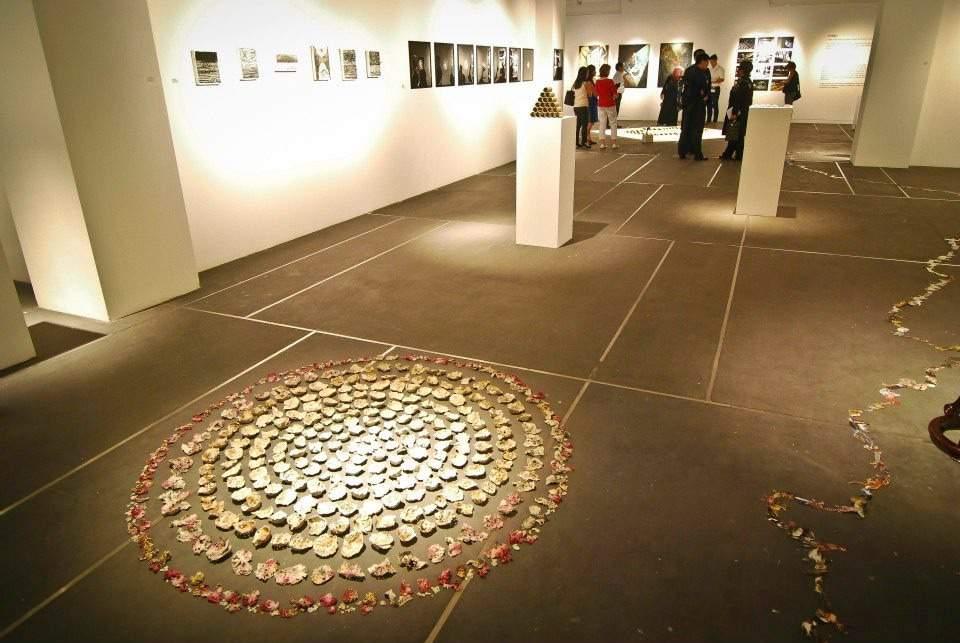
By Mdm Victoria Loy, Master Teacher (Art)
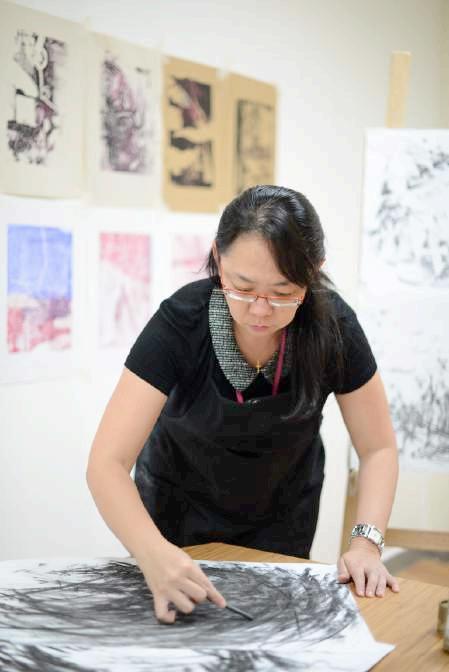
In this essay, Master Teacher(Art), Mdm Victoria Loy shares about her own art practice. Looking into her own thoughts and processes behind the creation of her artworks based on “Trees” as the source of inspiration, she examines how such artistic inquiry, though personal, can serve as rigorous practice-led research that informs one’s art teaching.
Artists are attracted to materials in a special way. For any art making, we would need materials. Material refers to “matter from which a thing is or can be made”. Materials take many forms: physical substances, sensory perceptions, and ideas. By physical substances I mean traditional art media such as pastel, wax, oil paint, modelling clay et cetera, things found in nature and manmade found objects such as a rusty coil of wire, a discarded bicycle wheel or empty bottles. By sensory perceptions I mean encounters, what we see on the way to school, the sound of a closing MRT door or the taste of home-cooked food that reminds us of home. By ideas I mean thoughts, processes or possible courses of action that are incomplete; these are dormant but full of potential. How can forms and personal meaning be synthesized to create an aesthetically pleasing object that conveys a meaningful experience? This is one of many questions that challenge artists through history till today. Can we bounce off ideas with “materials” instead of with a person? Which materials should artists use to facilitate a conversation with others? What kind of “material” dialogue will reveal the creation something about ourselves or our relationships with others? In this essay, I begin our conversation on materials.
Consider this quote:
“Learning is a process of discovery in response to significant and worthwhile questioning. When an artist searches for a special combination, ponders over tantalizing results, and decides to retain or reject a possible solution, the questioning and the thinking become so fused that one cannot happen
without the other and without the participatory role of the object of relationship (material).”
In art making, the explorations with materials “foster new dimensions of relationship with this other and the space between them becomes a meeting place for the crystallization of ideas and feelings into a form.” (Leo-Paul Cyr p. 10-11) If materials could be personified, an artwork is created to absorb the artist’s and the materials’ most intimate and inner states of being. Physical substances, sensory perceptions and artistic processes are used to “materialise” creative ideas.
In every successful creation of a masterpiece, many iterative cycles of research, thinking and experimentation have preceded. However, these processes may not be successfully captured in the final masterpiece if the processes of art making are not documented and shared. Documentation in aesthetic practices could include investigative studies of various forms and the experimentation of various media recorded on paper, film or digital files.
Historically, artists might have been perceived to leave their art creations unexplained, leaving the interpretation to viewers who may not have any background knowledge or experience in art making. Explanations are hence obscured, and common folks are misled to view the creative process as an intuitive and arbitrary process. If this process is not articulated, the viewer would not understand that art making is a very robust and rigorous investigative discipline. However, despite the rigour, the processes are not prescriptive, but discursive and reflexive unlike other form
of research. Artistic inquiry, if well understood, holds its own weight as a form of knowing and feeling.
According to Leo-Paul Cyr’s “The role of “things” the study of and the choice of material is a form of “adventurous thinking”. The person creating is “getting away from the main track, breaking out of the mould, being open to experience, and permitting one thing to lead to another” (Barlette, 1958, p. 103) “This abandonment, to let things lead from one action and the decision to another, acts as a cementing force between artist and materials. Artists use materials to mediate between intuition and imagination and between new and acquired knowledge. By using the nature of a material to relate to a new or existing aesthetic demand, artists have carved for themselves, and for others new meanings and new orders of experiences.
Allow me to describe the investigative process behind my self-made assignment, “trees”. I began by working on my investigative studies on the theme “trees” and creating a mind map. I made a field trip to the Singapore Botanic Gardens to “immerse” myself in the environment where trees are. This allowed me to translate the visual experience of “trees” into a non-visual form. I created a poem based on my own observations, experiences and feelings about trees. Then, I rendered my ideas onto my sketch book. This led me to create other visuals from the narration of my own poem, while making references to the photographs I had taken during the field trip.
I was fascinated by the roots of trees. Roots are the most important element that anchors and supports a tree. In the book “Oak: The frame of Civilization”, the author, William Bryant says: “If a tree puts on a lot of top growth and few roots, it is liable to be weak-wooded and short-lived…. If a tree puts down a great deal of roots and adds shoots slowly, however, it is liable to be long-lived and more resistant to stress and strain.”
In a way, organisation and trees share similar characteristics. For a tree, if the shoots grow faster than it puts down roots, the tree will likely turn out to be fragile and be in danger of breaking, falling and even dying. Similarly, if a person or organisation rises to eminence too quickly, it is in danger of failing. This led me to reflect upon our educational system and what we do in our schools. In the hustle and bustle of our daily lives, how much emphasis do we place on (hidden) “roots”, the foundations or strong fundamental which are of vital to education? What is education’s essence; what are its roots? What has been neglected in a “pressure cooker”, though it produces results? What have we given up while chasing “awards”? In many cases, teachers are pressurized to complete the perceived prescribed content of a given syllabus. Do they really have the time and the heart to care for each individual student? The fundamentals, like values and discipline, are often short-changed if we aren’t too wary. Aren’t these fundamentals the heart of education?
With these series of thoughts as a starting point, I created a series of drawings based on roots. This series of drawings reminded me to focus on “roots”, the fundamentals of life. This art practice helped
me to refocus and re-prioritise what is really important to me in my life. For one of my final artwork series, I have created an acrylic painting on canvas Artwork No. 1 entitled “Roots or Shoots” (image below). The artwork can be viewed from two perspectives focusing on either the roots or the shoots. For the background, I explored using batik dyes to create some special textural effects. A branch and some twigs collected were intentionally chosen as painting tools for my art work. Drawing with a branch offers a unique experience in mark making. For the bark of the trees, I used impasto gel medium to build the tactile and textural qualities observed from a tree. When the medium is completely dried, a layer of acrylic paint is applied using the dry brush technique. Through this artwork, I remind myself to look at a situation from different perspectives.
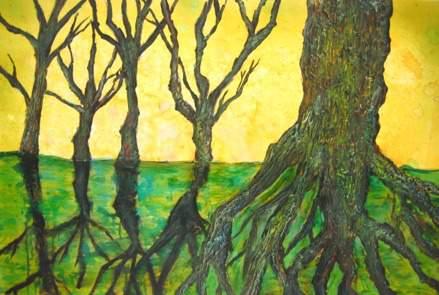
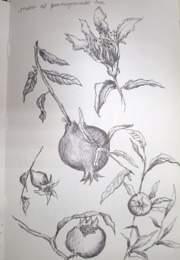
Studies of the frangipani tree which is near my home were made. I love the beautiful form and details of the flowers. The pomegranate tree planted by my mother was also drawn. In fact, I just learnt that pomegranate is classified as a tree. Given it’s diminutive size, all these years, I had mistaken it for a shrub. I was fascinated by the details found on the flowers and fruits.
The Chinese believe that the pomegranate tree brings “good luck” as the flowers are red in colour. I remembered when I was younger; my mother would pluck part of the branch with leaves and place it in our pockets. It is believed that it will cast bad luck away and bring good luck. The pomegranate also symbolises “fertility” in Chinese culture.
As the fruits bear many seeds, the Chinese associate this tree as an auspicious tree that will bring abundance and plenty of offspring in the family. As I sketched the interesting parts of the tree, I see the possibility of using such a tree to represent Singapore now. The government has been encouraging young couples to have more children to sustain our growth. A white paper anticipated that the population will and should grow from the current 5.3 million to about 7 million by 2030 in order to sustain the city-state’s competitive edge. The seeds of a pomegranate could also symbolized the potential of our future generations.
During the investigative process, I was inspired by photographs of Bonsai I took at the Botanical Garden. I created drawings of these miniature trees. To learn more, I went to the library to borrow some books on this. Growing Bonsai has been associated with giving the carer therapeutic benefits: innate peace and tranquillity, and an appreciation of Zen aesthetics. Bonsai is said to have a calming influence on the mind and spirit as they help to relieve stress. Keeping a Bonsai is not about gardening only, but it could be regarded as a form of Art and spirituality combined with horticulture techniques. Like art and design, Bonsai is never finished. It continues to grow and change, which means that perfection is always transitory and beauty is only momentary. Like art making, growing a Bonsai is a never-ending quest for perfection. Like art, Bonsai growing is a way of life. It requires commitment, dedication, time and resources.
As an art teacher, my goal is to help students to investigate, make art connected with their lived experiences with as much freedom as possible. I believe that Art has the power to free their imagination and liberate their souls. Sadly, in reality, I have observed that in some schools, the importance of ensuring that students will be able to score well enough in examinations had been overly emphasized. Fundamental questions like “will the process of inquiry taught in schools help students in their lives after schooling? How will they become better people and help others?” can lessen in priority if we do not speak about them or actualise them in our teaching.
The next series of work was based on the concept of “breaking through”, suggesting “roots” breaking through rigid organic forms of a boat, an “egg” or “seed”. I explored various ways of showing the roots emerging from the form. What are the best materials to use to execute the idea? Do I make 2 dimensional works, relief or 3 dimensional works? These are the next set of questions that must be considered.
For my series of 2D paintings, I explored something I have never done before. I used batik dyes to experiment and create interesting background effects on my canvases. I immersed myself in the media and let the media guide me on the strokes or splashes I create. The dye runs in a particular way, reacting to the toothed surface of the canvas. This way of mark making might seem incidental and experimental, but this allows me, the artist, to “listen” to what the medium wants to tell me what I might do next.
In the grander scheme of Art Education, visual arts practices could be viewed as the main trunk of a tree with roots and branches into other expressive modalities (e.g. design, architecture) . According to Graeme Sullivan 2005, the Visual Arts Research Model mirrors the “tree” index structure that emerges when the NUD.IST computer assisted qualitative data analysis software is used (Gahan & Hannibal, p.1008).
In terms of the deconstruction and reconstruction of the index trees, the process is like removing branches from an emerging tree structure and repositioning them in places that are theoretically more stable. In my opinion, research can be integrated with practice at all levels to promote creation of new knowledge, enrichment and
creative renewal. Research methodology through art making can be considered “empirical” as there is a direct involvement between the artists and the final artwork created. By empirical, we mean “based on, concerned with, or verifiable by observation or experience rather than theory or pure logic”. Research and practice are inseparable and mutually dependent. There is no reason to make a dichotomy between the two. Creating art requires modes of inquiry which are based on the principles of artistic knowing. We first need to recognize that there are issues and problems that are multifaceted and these facets require diverse methods of investigation and explorations.
Hence, Art making or practice-led research is a method of inquiry which uses art making experiences, as ways of understanding a phenomenon, or the significance of what we do within teaching or art making. C.G. Jung described how it all depends upon how we look at things (Jung, 1997, p.91). As we look in new ways, we will create new knowledge.
The greatest challenge presented by practice-led research, ironically, is the boundlessness of possibilities. Unlike quantitative and qualitative research, which follows a sequence of standard steps, practice-led research is more spurious and challenging. In a creative process, practice-led research may often encounter uncertainties. It encompasses constantly adapting the methodology of inquiry. This emergence of self-searching, constantly redefining the direction and scope when required, is often an unpredictable series of explorations. Art-based inquiry, like art making often includes carefully planned studies but the truly distinguishing
feature of creative discovery is the embrace of the unknown. So a research direction can be abandoned for something deemed more important and hopeful. The artists use their skills, unique sensitivities and artistic experiences to research a chosen problem or topic they desire, either directly or metaphorically.
Hence, as practitioner artists, we can be researchers. If we believe in our intellectual capacities, artistic methods and our unique artistic epistemology, Art practice can create thoughtful, thorough and careful practice-led research. We can contribute in our own ways to the research community. In addition, art making can also make unique contributions to other disciplines as we expand inquiry with artful knowing.
To end this essay, I encourage you the reader to make an attempt to slow down, think and reflect deeply to make meaning and to articulate your creative thought processes. “The generative powers of a creative expression need to be fed with a corresponding consciousness which appreciates and keeps their mysteries.” (Pat Allen ‘Art is a way of knowing’ 1995). By slowing down, appreciating the mysteries of life unfolding, we give ourselves the opportunity to learn more about ourselves and our students.
Leo-Paul Cyr (2002), The Role of “Things” as Otherness to Self in Shaping Experience, Teachers College, Columbia University.
Elliot W. Eisner (1979).The Use of Qualitative Forms of Evaluation for Improving Educational Practice. Educational Evaluation and Policy Analysis, Nov-Dec, 1(6), Stanford University.
Gardner, H. (1993). Frames of mind: The theory of multiple intelligences (10 anniversary ed.). New York, NY: Basic Books.
Brad Haseman. (2006). A Manifesto for Performative Research. Media International Australia incorporating Culture and Policy, theme issue “Practice-led Research”
Graeme Sullivan (2005). Art Practice as Research, USA: Sage Publications, Inc.
References
Ary, D., Jacobs, L. C., Razavieh, A., & Sorensen, C. (2006). Introduction to research in Education, (7th ed.). Belmont, CA: Thomson Higher Education.
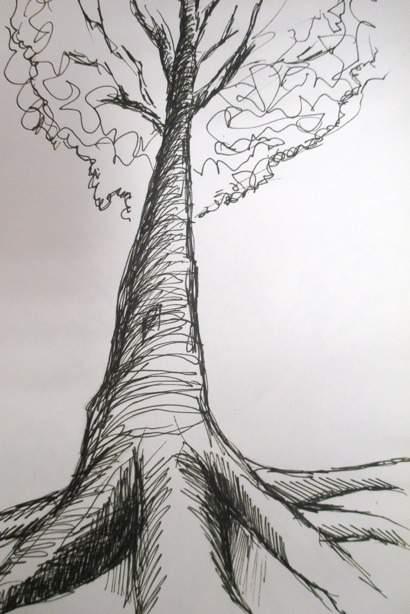
A quick sketch of a tree done during my trip to Singapore Botanic Gardens. I am amazed by it’s height and strong roots...am reminded about it’s resilience.
25 - 29 Nov 2013
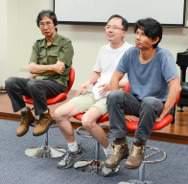
In conjunction with a-edge, STAR organised a 5 day intensive art camp to offer teachers the time and space to conceptualise and work on producing an art work for the exhibition. STAR invited 3 prolific artists, Chua Chye Teck (Photography), Tang Mun Kit (Assemblage) and Loh Lik Kian (Ceramics), experts in their own fields, to serve as mentors to conduct tutorials for our camp participants. a|edge, an acronym for ‘Art Educators’ Developmental & Generative Explorations’, is an annual art teachers’ exhibition. It encourages art teachers to sustain and hone their art practice, as their continuous engagement with art materials and art processes would enable them to add depth to their instructional practices and have the necessary versatility to engage their students more effectively. The exhibition also provides a space for professional dialogues on the fraternity’s ongoing conceptual journey in the arts.
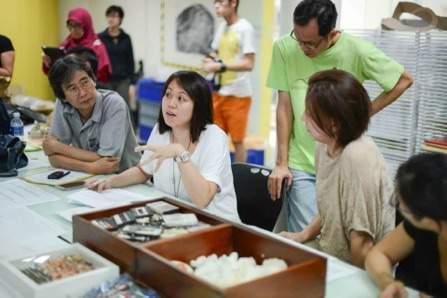
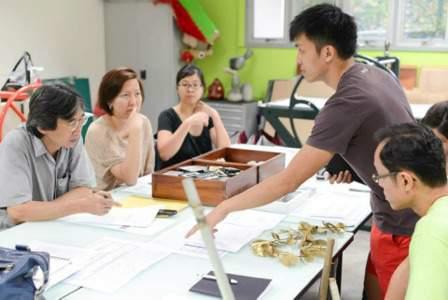
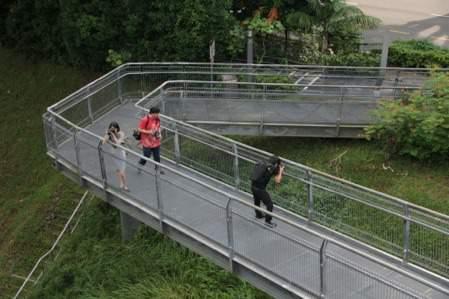
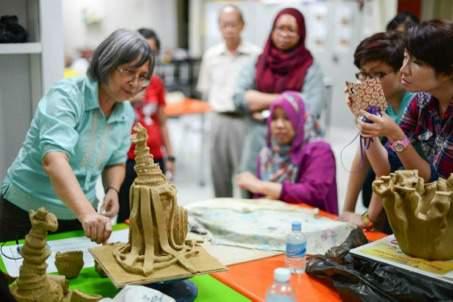
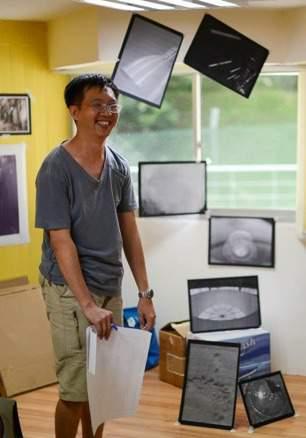
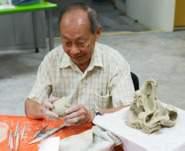
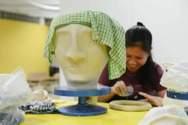
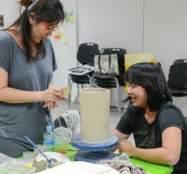
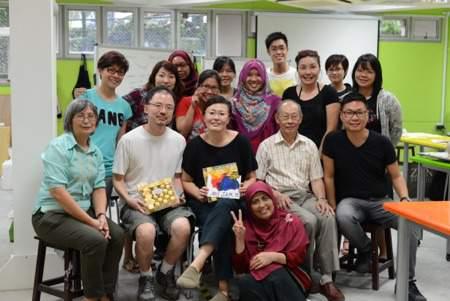
The annual art teachers’ exhibition a-edge will be held at SOTA Gallery from 7 – 19 March 2014. More than 30 art colleagues will be exhibiting in this group show; do drop by to learn more about their personal art inquiry and immerse yourself in this visual feast!
a-edge sneak preview
There will also be a curator’s talk on 15 March (Sat), 2-3pm. To register for the talk, email aedge2014@gmail.com with your name, school and contact number.

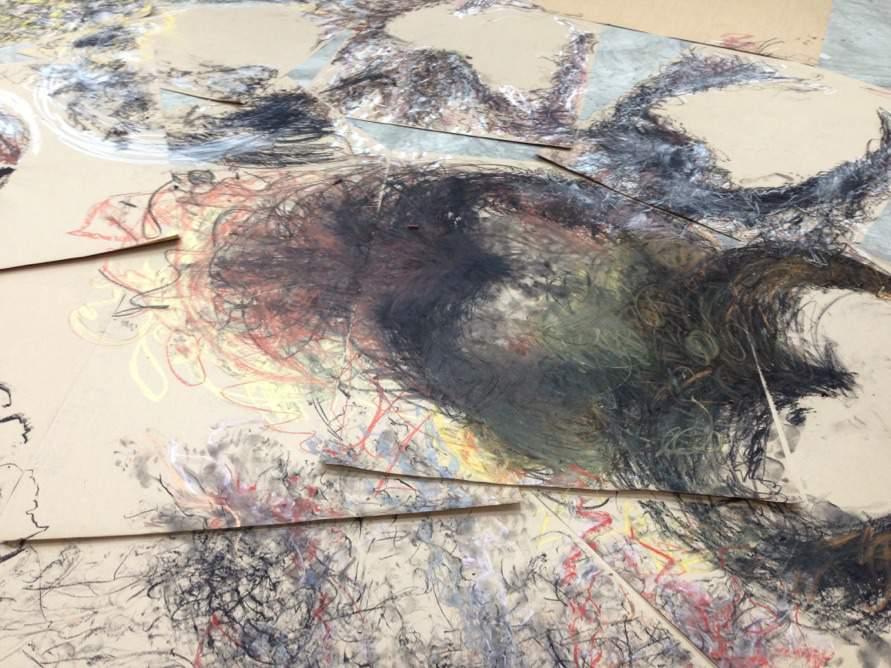
by Ms Eileen Ong, Northbrooks Secondary School
Ms Eileen Ong took part in STAR Senior Teacher (ST) Programme in 2013. Below is a research essay she wrote during the programme.. STAR ST Programme is designed to guide participants to coach and mentor others better by reinforcing participants’ pedagogical content knowledge in art and equipping participants with lesson observation skills to help other art teachers improve their instructional practices.
ABSTRACT
In the 21st century, the teacher is no longer the only source of information. Learners discover and gain knowledge through observation, exploration, experimentation and experience. As teachers, we now facilitate learning by designing activities and make use of spaces that increase inquisitiveness and learners’ capacity to learn. Transforming the art classroom into the ‘third teacher’ enhances learning experiences for students as they get to be observant, learn to gather data through all senses and discover new knowledge. What is the environment as the third teacher? Why is it important to create this third teacher? What does this third teacher look like? How do I go about transforming my art classroom into the third teacher? In this paper, the discussion on the potential of ‘the environment as the third teacher’ serves to provide some directions for the transformation and designing of effective learning environments for secondary school students.
One of the major influences on this study is the work of early childhood educators from Reggio Emilia who see the environment as the third teacher. The Reggio Emilia approach sees the environment as a living and changing system. The atelier, or art studio is an example of an ‘environment’ created from a physical space. An atelier is a studio furnished with a variety of resource materials used by all the children and adults in a school. It contains a wide range of media and materials fostering creativity and learning through projects. It provides a place for the children to explore and experiment with a variety of techniques and media. It also assists the adults, through keen observation to understand the process of how children learn and constantly make changes in the environment to support the learning. I firmly believe that the physical environment has the power to influence and shape all learning and teaching beyond early childhood and would like to explore the possibility of creating the third teacher for the secondary school students (13 to 16 years old) based on the Reggio Emilia approach. As Zeynep Inan (2009) states, the creation of a supportive environment is as important as planning a curriculum as it will support the teacher, the children and the curriculum.
I also believe that children are born with the natural ability to discover the world they have entered. Children are full of curiosity and creativity. According to Jean Piaget’s theory of cognitive development, children have all the cognitive mechanisms to learn on their own and the interaction with their environment allows them to do so. Piaget believed children cannot learn unless they are
constantly interacting with their environment, making mistakes and then learning from them. From the age of 11 years onwards, according to Piaget’s theory, children reach a formal operation stage. They acquire the ability to think hypothetically and “outside the box”. When presented with a problem, they can consider solutions to the problem in a logical manner. Children become increasingly “adult-like” with regards to their cognitive abilities.
Hence, I would like to present the current learning environment in my art room as a ‘problem’ and include my students in making decisions about spaces they utilize and through this co-creation, affirm the importance of their opinions. Lastly, in my research, I see the role of a teacher as a learner and reflective thinker, constructing knowledge alongside the students. The teacher works together with the students in exploring, experimenting and discovering new knowledge. The teacher as a reflective thinker continually sharpens his/her observations and listening skills. The teacher takes the cue from the students and makes adjustments to the learning environment to enhance students’ learning.
The Reggio Emilia Approach (REA) to early childhood education sees the environment as third teacher. This is a term used by Loris Malaguzzi, the founder of the Reggio Emilia schools. According to Loris Malauzzi, “there are three teachers of children: adults, other children and their physical environment”. REA believes that great care must be taken by the teacher to design a learning environment
that is aesthetically engaging and provides open spaces for children to explore and learn. The importance of the environment lies in the belief that children best create meaning and make sense of their world through environments.
I believe that the environment has the power to influence and shape all learning and teaching. A learning environment designed as a third teacher will provide students the opportunity to become actively engaged, make their thinking visible and foster further learning. It is an environment where the adults are engaged with, and in the students’ learning. As Mckellar (1957) states, such an environment is one where physical space nurtures concentration, creativity and the motivation to independently learn and explore. On the other hand, there is some evidence indicating that if the classroom is poorly designed and planned, it will not support children’s development and growth and will lead to inattentive and frustrated children.
In The Hundred Languages of Children, author Leila Gandini quotes Loris Malaguzzi, “We value space because of its power to organize, promote pleasant relationships between people of different ages, create a handsome environment provide changes, promote choices and activity, and its potential for sparking all kinds of social affective and cognitive learning.”
I began to actively look out for the third teacher whenever I visited schools in Singapore and on my Taiwan study trip.
I often go to Huamin Primary school in Yishun for cluster workshops. It was awarded Programme for School-Based Excellence status in 2010, Niche in Creative Arts Programme. The school has a strong emphasis on visual arts. Students’ artworks are displayed at every corner of the school and on the windows along the corridors. There are also artists’ artworks with information on the artists’ background displayed around the school compound. In the art classrooms, the noticeboards are filled with

students’ artwork and every student keeps an art journal The art classroom environment is very lively and colourful. There is so much to see and explore upon entering. There is
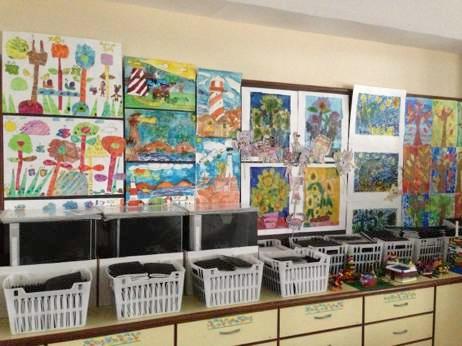
strong evidence of effort to create an environment where learning is made visible for the students.
This was the first school that I visited on my Taiwan study trip. The location of the school is very conducive as it is set amidst natural environment (located at the foot of Da-Tun Mountain) which students can draw inspiration from. It is the second largest senior high school in Taipei city. The school runs an established and renowned art programme since 1997.
The school displays students’ artwork to invite further study of a particular issue, provoke interest in the visual arts as as well enhance the environment. The senior teacher also shared one project that involved and encouraged students to participate in designing the school landscape and through the process, gain deeper aesthetics appreciation. The winning student team were given a sum of money to actualise the proposed idea. One of the features of the classrooms was the large open space. Students sat freely and comfortably on the floor with their art materials and were experimenting with various mediums.
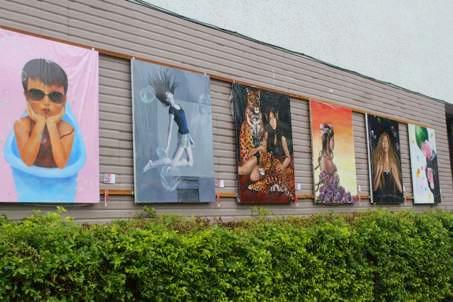
T HE A FFILIATED S ENIOR H IGH
S CHOOL OF N ATIONAL
T AIWAN N ORMAL
U NIVERSITY , T AIWAN
The Affiliated Senior High School of National Taiwan
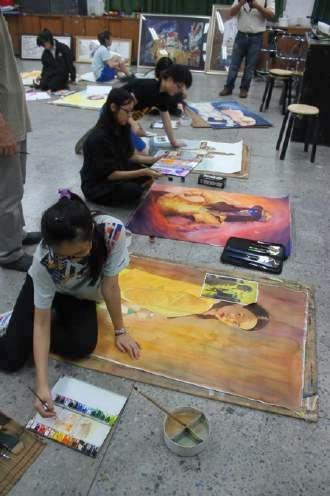
Normal University is one of the renowned schools in Taipei which emphasize the importance of Art Education.
Similarly, I observed that good artworks by students were framed and hung up on the wall along the corridors of the school. In the art classroom, big tables were used to facilitate group work. In a lesson that I observed, the class was split into two, both using Chinese brush painting as the medium. In the first group, the teacher tapped on the school environment and surroundings to get students to make keen observations and record their findings in their sketchbooks using calligraphy brushes. In the other group, the students were given free-play and encouraged to experiment with the materiality of Chinese brush painting, watercolours and mediums. Through the process, many of them produced work that were more contemporary, compared with traditional sketches, and showed strong personal responses and expressions in their work. In another charcoal drawing lesson I observed, the teacher, despite a big class size of 40 students managed to engage all her students. She displayed good students’ work and played relevant videos to assist students in their learning.
In conclusion, it is apparent to me that the third teacher exists in one way or another in the above-mentioned schools. Visually stimulating artworks displayed in the school compound and art
classrooms served as resources or inspirational references. These raised the visibility of the subject and informed school management and parents. I could see that much effort and energy had been devoted to the planning of new spaces and the remodelling of old ones with the belief that students can best create meaning and sense of their world through their environments. Hence, from the observations of these schools, I became excited to explore transforming my art classroom into the third teacher.

I set out with the goal of transforming my art classroom into the third teacher, bearing in mind, that a dynamic learning environment requires close observation, continual adjustments based on the learning needs of the students and constantly reminding myself of the learning intentions.
In my school, there are currently two art classrooms. Each art classroom has about 40 desks and chairs and some bigger tables for group work. Furniture are seldom moved around. Noticeboards in both classrooms are bare.
I gathered feedback from my Secondary 3 Express students, posing them the question, “What should the art classroom be like or look like?”. From my students’ responses, I summarized that for the environment to serve as the third teacher, it should be inviting and full of visual stimulus such as students’ and artists’ artworks and posters to inspire them. Some of them even wanted to be given the opportunity to play with other materials and mediums. From their responses and my observations of other schools, I started making minor changes in the environment in an attempt to create the third teacher in the art classroom.
(i) A Safe Environment
All learners must feel that they can safely take risks as part of exploration and constructivism. According to the Maslow Hierarchy of Needs theory, there are 5 levels of need. Once the physiological need has been addressed, the next level is the need for safety and security. In the book, The Third Teacher, the author also suggests putting safety before study. Teacher encouragement and a safe
environment for experimentation, and play supports the reinvigoration of the artistic excitement. With that in mind, I constantly affirm each individual learner’s strengths. I also reminded my students that making mistakes in the art-making process is common and to accept those mistakes as springboard for new directions.
(ii) Display of students’ artwork
Display of students’ artwork serves as a form of motivation. It makes
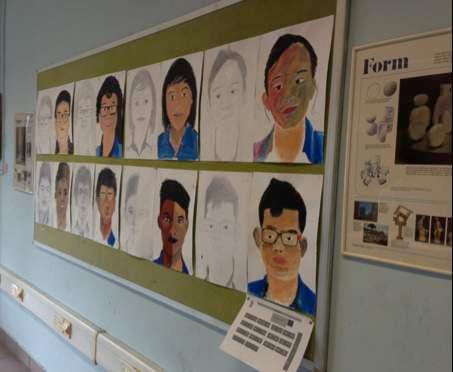
the students feel validated, boosts their confidence and develops future interest. Displaying students’ work, both current and past,
tracks progress in a visible way. It also helps to create students’ ownership of the room. I started to put up my students’ selfportraits on the noticeboard and observed that they were indeed happy and proud to see their work. They were even positively reaffirming each other. Apart from displaying students’ artwork, I will be putting up more educational posters on various artists or art movements.
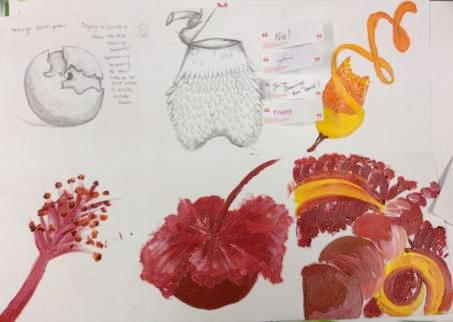
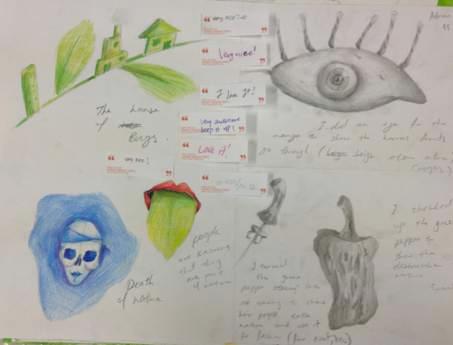
Kerka (1999) suggested that an environment that nurtures learning provides the necessary resources and time for investigative play and experimentation. Many of my students tend to use colour pencils and poster paints. I realized many of them may not have come across many other media. I would like to create an exploration and experimentation corner where students can experience and play with various media. In an interview, Professor Olivia Gude shared on the use of the ink blot corner, where the students, when out of ideas, could go to to experiment and play with the ink blot. This helped to ease the students’ frustration and help them generate ideas.
I like the idea of creating a bulletin board, a suggestion by Katherine M. Douglas and Diane B. Jaquith. In their book, they suggested having a bulletin board that reads: Where Do Art Ideas Come From? Students from the various grades list their own sources and where they think ideas of adult artists come from. Students consult this bulletin board if they need a start to their work.
I adapted the idea and tried something similar with my Secondary 4NA students. I got each one of them to share how they generate ideas and I recorded their sharing on the whiteboard and left it visible for the entire lesson. The list of ideas was really helpful and my students, by referring to it, managed to create at least 6 development drawings within an hour of the lesson. The bulletin board can be put up at the exploring and experimenting corner for students to make timely reference.
In an art classroom, the arrangement of learning space is often an important considerable. The environment as educator is full of variety, with spaces for discussion, for wondering, and for reflecting. Each space and each small corner can have an identity and a purpose. Hence, no space is marginal and each space needs to be alive, flexible and open to change. I experimented shifting the furniture with my Sec 4 Normal Academic class of 26 students. Initially, two students shared 3 desks, the students were easily distracted during lesson time due to the close proximity. Furthermore, they only occupied half of the art room. I decided to shift the desks such that each student gets a bigger workspace (2
desks) and we used the entire art classroom. I observed that the students became more engaged during the lesson with the new furniture arrangement.
Along the journey as I was making the changes in my art classrooms, I shared my ideas with my fellow art teachers. In considering what’s next, I would like to work collaboratively with my art colleagues to document my students’ learning and continue to transform the art classrooms. In the process, we hope that we can create an environment where we have a strong sense of ownership and where we can work together with the students in exploring, experimenting and discovering new knowledge.
The physical environment is more than just a simple container for learning and learning. Rather, the environment can be seen to be a central component of the learning and teaching relationship. Its impact on learning is certain. For the environment to serve as an effective third teacher, the teacher must play an important role in observing, recording, reflecting and changing the environment.
Acknowledgements
I wish to express my sincere thanks to my school leaders for giving me the opportunity and support to be on the Art ST Milestone Programme, to the many Art teachers and students
who shared their thoughts and to Master Teacher, Mdm Victoria Loy from STAR, and Mrs Daisie Yip for providing the guidance in writing this paper.
References
1. Samuel Eddy (2010), Theories of cognitive development: Jean Piaget [online]. Available: http://psychohawks.wordpress.com/2010/09/05/theories-of-cognitivedevelopment-jean-piaget/. (September 5, 2010)
2. RVIS Reggio Emilia Early Childhood Philosophy: Position Paper [online] Available: http://www.rvis.edu.bh/uploaded/news/Reggio_Emilia_Nursery_Program__Position_Paper_doc.pdf
3. Katherina Danko-McGhee (2009), The Environment as Third Teacher: Pre-service Teacher’s Aesthetic Transformation of an Art Learning Environment for Young Children in a Museum Setting, International Art in Early Childhood Research Journal, Volume 1, Number 1. University of Toledo.
4. Hatice Zeynep Inan (2009), The Third Dimension in Preschools: Preschool Environments and Classroom Design, European Journal of Educational Studies 1(1), Ozean Publication.
5. Delany, K. (2011), Waking the ‘Third Teacher’: the Whys and Hows. Te Wjarolo; Principle to Practice.
6. Tangient LLC (2013), Loris Malaguzzi. [Online]. Available: http:// ece205.wikispaces.com/Loris+Malaguzzi
7. Katherine M. Douglas and Diane B. Jaquith (2009), Engaging Learners through Artmaking: Choice-based Art Education in the Classroom, Teacher College Press.
8. A Collaborative Project: Cannon Design, VS Furniture, Bruce Mau Design (2010), The Third Teacher: 79 Ways You Can Use Design to Transform Teaching and Learning. Abrams.
9. Diane B. Jaquith and Nan E. Hathaway (2012), The Learner-Directed Classroom: Developing Creative Thinking Skills through Art, Teacher College Press.
10. Gandini, L., Hill, l., Cadwell, L. and Schwarr, C. (2005). In the Spirit of the Studio: Learning from the Atelier of Reggio Emilia. New York, NY: Teachers College Press.
11. Louise Boyd Cadwell (1997), Bringing Reggio Emilia Home: An Innovation
College.
12. Professor Olivia Gude, Coordinator of Art Education and an Associate Professor in the School of Art and Design at the University of Illinois at Chicago, personal interview, 18 Jul y 2013.
13. The Reggio Emilia Approach to Early Years Education (2006) [Online]. Available: http://www.educationscotland.gov.uk/Images/ReggioAug06_tcm4-393250.pdf.
By Grace Kwa, Programme Manager (Art)
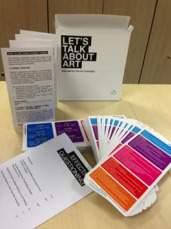
In a recent workshop at STAR, participants were introduced to some questioning strategies to engage students in art discussion. Hamblen’s Art Criticism Questioning Strategy and selected Core Routines from Harvard Project Zero’s Visible Thinking were used.
Based on the art exhibits shown at Gillman Barracks and selected questioning strategies, participants worked on series of questions that can be used to scaffold learners’ looking and talking about contemporary art. Pages 22-24 are some examples of responses contributed by myself and Primary school Art teachers from this workshop.
For more details, please refer to the ‘Let’s Talk About Art’ Inquiry Kit which had been sent to all Secondary Schools & JCCI last year. A similar kit for the primary schools is currently in the prototype stage. More details will be made available to Primary School teachers from term 3.
Well-constructed teacher questions that guide student inquiry contributes to students’ grasp of concepts, eventual efficient and self-directed learning (Armstrong, 1993). This is consistent with Packard’s study (1973) that reported little difference in time taken (as opposed to time given) to complete an artwork well even though more time was spent on productive talk. Effective questioning strategies, or planned questions, may therefore be useful to initiate verbal interaction that encourage reasoning, critical thinking resulting in positive learning outcomes.
Planned questions are used in classrooms to assess learning, instruct, manage the learning environment and promote cognitive and emotional engagement (Sapier et al, 2008, p. 206). A question is an immediate tool a teacher can use to prompt students to think and act. Planned questions can be used for formative assessment, and several question-answer exchanges can help students make connections with prior knowledge. Probing questions by the teacher or student encourages sustained and extended dialogue. The type of question to ask will depend on its purpose. Students’ verbal exchanges can be sustained if the teacher facilitated thinking, and further questioning to that purpose. Questions can be used to lead and facilitate students’ discussion on art, as well as in their art making.
Questioning strategies introduced in the toolkit help to frame questions so as to develop art teachers’ questioning skills. By consciously reflecting on how students respond to different question types, teachers can continue to hone their verbal questioning skills until it becomes second nature.
Armstrong, C. (1993). Training in an art production questioning method on teacher questioning and responses, Studies in Art Education, 34(4), Summer, 1993, pp.209-221.
Packard, S. (1973). Creative tempo in children's art production, Studies in Art Education, 14(3), pp.18-26.
Sapier, J., Haley-Speca, M., & Gower, R. (2008). The Skillful Teacher: Building Your Teaching Skills. Research for Better Teaching.
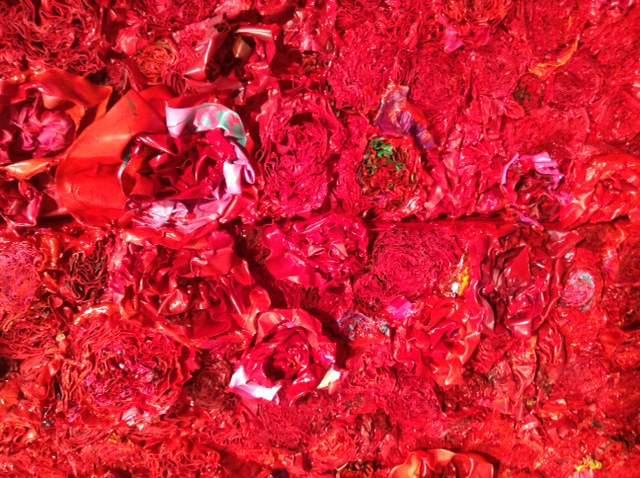
Jane Lee, Fetish Series, 2013, Mixed media
Broad Question Scaffolding Questions Possible Responses
How much paint did she use?
What questions or puzzles do you have?
Broad Question
Scaffolding Questions Possible Responses
What do you think you know about this art work?
1. What do you see?
2. Does the painting remind you of anything you recognise or experience?
3. What emotions do the painting bring out in you?
4. Can you think of a suitable place to display this painting? Why?
5. How is this painting created?
1. & 2. Red paint, roses, layers of dried acrylic paint folded and crushed together
3. Passionate, Intense, Fiery, Disturbing, Overwhelming, Curious
4. Staff room, to hypnotise the teachers with its rich texture whenever they feel stressed
5. Possibly by layering of dried acrylic paint, dried paint bunched up together and pasted onto painting’s surface
What does the artwork make you want to explore?
Do you have any questions about the artist’s work processes?
Do you have any questions about the artist’s intent?
How long does it take to complete this work?
How does she decide on the painting’s size?
What is the artist fascinated by?
What other materials and methods would create such effects/textures?
How else could you use similar art materials to arrive at different but tactile effects?
Possibly by using plastic bags or crepe paper crushed and tied together
Scratching and digging through thick layers of paint
THINK/PUZZLE/EXPLORE routine activates prior knowledge and generates curiosity and ideas. The second question challenges students to think beyond what they are sure of or have knowledge about. Group discussions, where other students’ input can shed light to existing ‘puzzles’, could be encouraged. The teacher might also want to set research tasks where students can find out more about the artist or artwork. The third question leads naturally to independent student inquiry and in this instance, students could use studio time to experiment and explore art materials to test out if their speculations about Lee’s processes might be correct.
Broad Question
Scaffolding Questions Possible Responses
What do you see?
1. What is the biggest element in the painting?/ What is the first thing you notice in the painting?
2. What’s the setting of this painting?
3. What is the figure doing? How is she portrayed?
4. Describe the colour scheme.
5. What are the materials used, how are the materials used?
1. The crouching figure; the repeated vertical columns; the green and white checked fabric
2. Surrealistic; dreamlike with floating fabric, wavy lines suggesting wood grains but also look like sea waves; view from under the table inside a house, details like doors, paintings on walls can be seen
3. She is hiding/playing; she is in a contorted pose like a gymnast; she is disproportionately small compared to the table.
4. Dominant colours are pale grey and yellow; muted colour scheme, except the contrasting green and white checked fabric
5. Precise and fine brushstrokes to bring out details like texture
This routine encourages students to make careful observations and thoughtful interpretations. Some students may require scaffolding questions before the moving on to the next question stem. For example, a student might be overwhelmed by the visual information and would require some prompts to direct one’s attention to certain components of the artwork.
Broad Question
What do you think about that?
Scaffolding Questions Possible Responses
Questions here could be teased out from the students observations: What do you think the artist is trying to portray through this dreamlike/ surreal setting? What effect do you think the colour scheme produces? What do you think of the contrasting effect between the soft fabric and the rigid table legs?
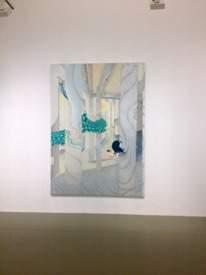
I think the artist is trying to recapture memories of her childhood and her living space.
I think the work is playful but quiet at the same time. There is that sense of loneliness, like the playful things children might do to entertain themselves when left home alone.
The rigid table legs can look like prison bars while the floating fabric looks like the wind is blowing. I think there is a yearning for the girl to get out of the confines of the home to be outdoors.
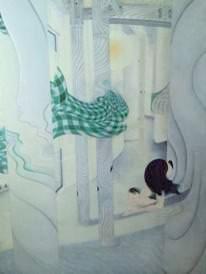
Students are encouraged to respond to the three question stems in sequence such that what they think (interpretation) is built on what they see (observation, description). It would be timely for a teacher to move to the second stem once enough observations have been made for students to connect these to the interpretations they have. Stem 1 and the following sequence can be revisited to discuss another aspect of the artwork.
Possible responses for the selected artwork based on the 3 stems:
Jane Lee - 100 Faces
Exhibition Details
Exhibition running from now till 2 March 2014
Sundaram Tagore Gallery
Gillman Barracks, 5 Lock Road, #01-05, S’pore 108933
Tel: 6694 3378
Stem 1
SEE
Stem 2
THINK
STEM 3
WONDER
I see a girl who seems to be crouching in a contorted pose. She appears to be under the table as suggested by the wooden table legs and the plywood that the table legs are supporting.
I think the girl could be engaged in a game of ‘hide and seek’.
I wonder why the girl is disproportionately small compared to the table and her surrounding.
Tomoko Kashiki
Exhibition running from now till 2 March 2014
OTA Fine Arts
Gillman Barracks, 7 Lock Road, #02-13, S’pore 108935
Tel: 6694 3071
Most galleries at Gillman Barracks are closed on Mondays.
For more details, visit: http://gillmanbarracks.com/ Stem 1
SEE
Stem 2
THINK
STEM 3
WONDER
The painting seems surreal with a girl emerging from one of the table legs, in a contortionist pose. There are disjointed floating curtains about the scene and wavy lines from the table legs that represent wood grains which seems to permeate onto the ground like water ripples.
I think the artist could be portraying a childhood memory, or a dreamlike moment of someone who is bored and alone, whose imagination have gone wild.
I wonder if this is a metaphorical painting about someone feeling trapped.

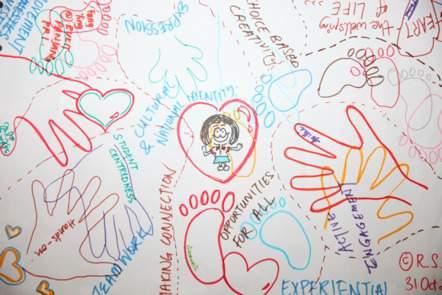
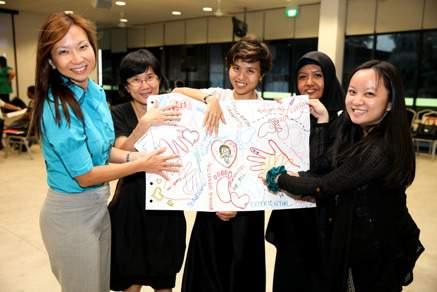
To my fellow teachers,
I am thrilled to have an opportunity to influence Arts Education together with all of you during this inflexion point. Support for the Arts has never been stronger. There are more qualified leaders, more teachers, more resources, and we have our very own
Singapore Teachers’ Academy for the aRts. The larger ecosystem is also developing. There is more support from key partners like the museums and the National Arts Council. Let us seize this opportunity today.
I have been pondering on the purpose of Arts Education in our schools. As a Science graduate who plays the pianoforte, was involved in church musicals, a regular concert-goer and museum visitor both in Singapore and overseas, it was not difficult to parse what the arts does for me. What it does for me is so essential, I would dearly want it for every child that passes through our schools. More than any other field, the Arts nurtures Creativity, Culture and Expression. This is the bigger purpose of why we are teaching what we are teaching. It goes beyond the elements of art or the theory of music. The arts is not a discipline. It is an experience, and a journey that changes us as we sojourn.
Creativity is inherently intertwined in the processes and the outcomes of arts education. The curricular outcomes in our art and music lessons present opportunities for process learning in our students, nurturing their creativity and allowing their imagination to take full flight. Creativity is so essential in our economy today. Our students need more of it in the future to be able to add value to their work. As human beings, we feel more fulfilled when we create. Design every arts lesson to nurture creativity. Be careful that our words, pedagogy and grading do not discourage our students. Templates, overly prescriptive directions (“draw it like this”, “sing it like this”) and lack of affirmation can erode creativity. You can give our students the precious gift of confidence to create. A blank
canvas or an open stage should not terrify our students, but should be a pleasure of opportunities and ideas they can bring to life.
Every civilisation is recognised for its distinctive art forms. It is a way for a community or society to transmit their ‘being’ from generation to generation. It is our Culture. The arts portray society’s way of life, conveys what is important, what beauty is, the essence of the community, its history and its heritage. Arts is our humanity.
Let our students discover their rich heritage through the arts. Let them experience it deeply through their five senses. Let it resonate in them. The arts must move their soul and spirit, and give them soul and spirit. Then our nation will have soul and spirit. Then we will know where we come from, where we are now and where we want to go.
The final important outcome of a rich arts education is Expression. The arts are living languages in another dimensional form. It evokes feelings and gives us another voice when we have no words to express how we feel. It is what we turn to when we are happy or sad or angry. It is an important outlet that helps us to maintain our sense of well being. It helps us work through our emotions. To use it as naturally as our language, our students must have enough familiarity, knowledge and skill to be able to wield it. It is a beautiful way to communicate. As social beings, expression is as important to us as oxygen is to living things.
Therefore what we teach must connect the child to life – his life, the lives of those he cares about, and the community he lives in. Otherwise the arts would be dry, boring and meaningless. Arts must be enjoyed. It cannot stay in the classroom. Create meaningful
performance tasks for our students so that they are excited about learning. Take them to relevant exhibits, hear and see real life artists and artistes at work. Let them do arts for others to experience. I charge each one of you to look at your teaching in this light, to convey these ideas to your colleagues and parents. You can be so much more as an arts educator. You can be the ones assembling the foundation stones for lives well lived, and a strong thriving Singapore for the next 50 years.
I would love to hear your response to my views. Do write to me at liew_wei_li@moe.gov.sg. I look forward to hearing from you.
Ms Liew Wei Li Director, Student Development Curriculum Division
By Ms Dee Chia, Arts Education Officer, Arts Education Branch
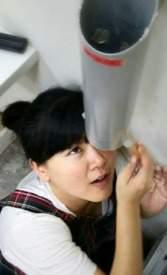
I am an Art teacher. I started my career as an Art teacher and will always consider myself an Art teacher.
In my 16 years in education with 11 nett years spent teaching in the humble Art room, I have been awed and inspired greatly by the artistic passion and abilities of students who have walked through the doors of the messiest room—yet a room filled probably with the greatest possibilities—in the entire school.
My best Art students came in many forms.
One of them, who is 26 years old now, did not take upper secondary Art nor complete secondary education. He was under police probation for suspected involvement in rioting some years back. Recently, I paid him a visit when I discovered that his mom was diagnosed with cancer. During the visit, we had a discussion about his school days and he said he was glad he enjoyed Art in school and that he spent sufficient time in the extremely hot spotlight-lit art room drawing corner. It was because that was the space that taught him foundational skills which were necessary for him to find a job eventually, and even do well now, as a tattoo artist. According to him, he now talks to younger folks about the importance of anger management and the dangers of associating themselves with gangs.
I have another interesting ex-student who is 31 years old this year. I wouldn't say she was one of my best Art students because I never taught her Art. But interestingly, a science student in the school's best class, she was always interested in the batiks which her close friend, my Art student, was working on. Despite the pungent smell of dye and wax, she was a frequent visitor in the Art room after school. Seeing her enthusiasm and recognizing the talent she has through her doodles, I encouraged her to pursue an interior architecture and design course in Temasek Polytechnic. I wrote her a long recommendation letter despite her not having ‘O’ level Art and despite the fact that I never taught her (pardon me, I was only 25 years old then). She was accepted into Temasek Polytechnic and her formal education in Art started. She is now a practicing ceramicist/sculptor who explores issues to do with the Singaporean identity through icons such as the Singa lion. She just held her 2nd solo exhibition last month.
I also had to ask one of my best Art students to weigh his odds and consider carefully about pulling himself out of the in-house Art elective programme and to pursue a talent programme for Literature because I could sense his unwavering passion for Art. At the same time, I also had an internal struggle as an Art teacher as I thought by opting out of Art as an academic subject, this child’s eloquence in writing about Art could be even better sharpened through studying Literature at an in depth level (the school called this in-depth elective "academies"). Oxymoronic as it may sound, my logic was, even if I was to lose him in the art programme, I was dead sure he would still be reflecting, writing about and making art. He continued with Art CCA despite his eventual decision to opt out of the Art academic programme in school. His outstanding leadership skills (he was the school's head boy) saw him successfully lead in community Art projects, such as one involving the hearing impaired. Even though not a perfect scorer for his ‘A’ levels, he credits being awarded the MINDEF Overseas Merit Scholarship because of his all-rounded-ness which included his love for both Art and Literature. Whenever he is back from the States during his term breaks, you'll see him at Art openings and Art events to support his friends whose works were on show or simply to hang out with his Art classmates from his lower secondary Art class, his closest friends till date.
I have chosen to outline cases of some of my best Art students who did not go through the route of upper secondary ‘NT’/’NA’/’O’ or ‘A’ level art because I would like to make a point about the power of activities in the Art classroom. However little depth we may think that we are teaching at the lower secondary general art or for the
matter during our Art CCAs, we do plant seeds of interest and passion in these young souls who are exposed to our art programmes.
Because in the art classroom, kids learn to translate their ideas into concrete creations or they observe artworks being created and get inspired. From what I observed in the art classroom, kids learn to critique one another’s works in constructive ways which build trust and friendships. With friendships, great teams are formed and people stay connected even after graduation because of good experiences they share through collective successes they experience together. And however unimportant or messy we may think our art rooms are, the random corner in the art room where a still life has been sitting there for who knows how long, with its dusty spotlight, might just be the favourite corner of a kid fascinated with the capturing of light and shadow.
I also discovered that art activities and the creations which come out of the art room, can in one way or another, inspire that child who may not have chosen to take Art wonder what life would be like if he or she had pursued Art.
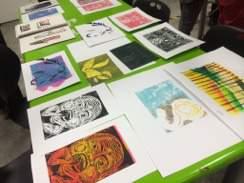

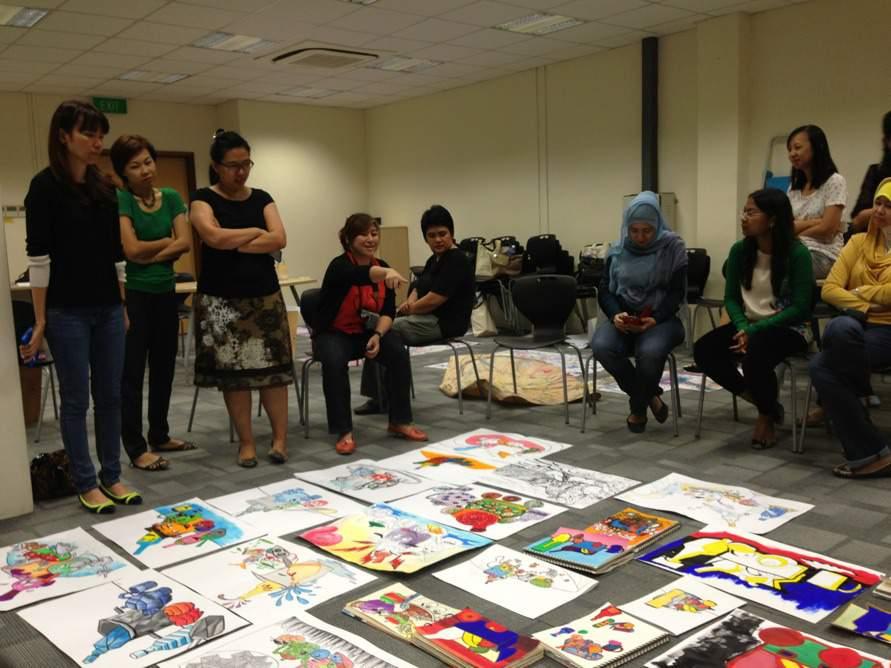
Photography Workshop All art teachers 21290
27 Mar2014 3 April 2014 10 April 2014 17 April 2014 24 April 2014
Printmaking Workshop for Art Teachers All art teachers 90008 15 April 2014, 22 April 2014, 29 April 2014
Plein Air Watercolour Painting Workshop for Art Teachers (Class 1)
Pri & Sec 21349
8 April 2014 & 9 April 2014
Fashion Illustration Workshop Sec Teachers 20845 5 May 2014 6 May 2014 7 May 2014
Plein Air Watercolour Painting Workshop for Art Teachers (Class 2) Pri & Sec 21349
28 Oct 2014 & 29 Oct 2014
FACILITATOR
Mr Sweng Lee (Photographer)
Ms April Ng (Printmaking artist)
Mr Marvin Chew (Artist, VP of Singapore Watercolour Society)
Ms Lynn Lim Li Yin (Artist, Lecturer at LASALLE College of the Arts)
Mr Marvin Chew (Artist, VP of Singapore Watercolour Society)
You may also find out more STAR’s other professional development programmes from our STAR Prospectus 2014 (7 mb) using the following link:
http://www.star.moe.edu.sg/star/slot/u1012164/Art%20Images/Art_Prospectus_27Jan2014s.pdf
Friday, May 9, 2:30–5:30 pm, and
repeated on Monday, May 12, 2:30–
5:30 pm
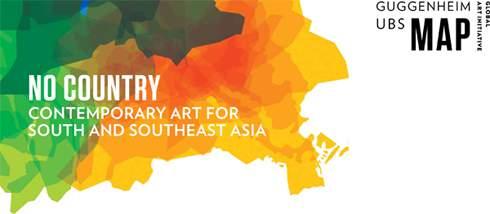
This program offers educators an exclusive preview of the Guggenheim UBS MAP exhibition, No Country: Contemporary Art for South and Southeast Asia, on view at the Centre for Contemporary Art, accompanied by a participatory workshop on teaching strategies designed to deepen engagement, support curriculum connections, and prompt critical thinking. A cross-disciplinary Teacher’s Guide to the exhibition containing information on artists and artworks, and suggested activities and questions for discussion, will be distributed to each participant.
Sharon Vatsky, Director of School and Family Programs at the Solomon R. Guggenheim Museum, New York, will lead the workshop and share techniques for engaging students with art and preparing them most effectively for visits to the No Country exhibition.
Early bird registration (till Term 1 Week 10) will be made available to those who had indicated their interest during Arts Education Forum held at ITE Central last year or via email to STAR. An email notification will be sent to the email addresses collected.
Registration will be available for all art teachers from Term 2 Week 1 to 2.
